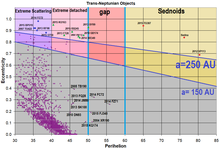(523635) 2010 DN 93
|
Asteroid (523635) 2010 DN 93 |
|
|---|---|
| Properties of the orbit ( animation ) | |
| Orbit type | EDO / EDDO DO SDO , "Distant Object" |
| Major semi-axis | 55.287 AU |
| eccentricity | 0.185 |
| Perihelion - aphelion | 45,066 AU - 65,507 AU |
| Inclination of the orbit plane | 40.6 ° |
| Length of the ascending node | 91.3 ° |
| Argument of the periapsis | 32.3 ° |
| Time of passage of the perihelion | January 23, 1972 |
| Sidereal period | 411 a 1.1 M. |
| Mean orbital velocity | 3.973 km / s |
| Physical Properties | |
| Medium diameter | approx. 490 km |
| Albedo | 0.07-0.09 |
| Absolute brightness | 4.8 - 5.1 mag |
| history | |
| Explorer |
Pan-STARRS : B. Gibson T. Goggia N. Primak A. Schultz M. Willman |
| Date of discovery | February 26, 2010 |
| Source: Unless otherwise stated, the data comes from JPL Small-Body Database Browser . The affiliation to an asteroid family is automatically determined from the AstDyS-2 database . Please also note the note on asteroid items. | |
(523635) 2010 DN 93 is a large trans-Neptunian object whose orbit classification is disputed. Because of its size, the asteroid is a dwarf planet candidate .
discovery
2010 DN 93 was discovered on February 26, 2010 by a team of astronomers consisting of B. Gibson, T. Goggia, N. Primak, A. Schultz and M. Willman with the 1.8 m Pan-STARRS telescope (PS1) Haleakalā Observatory ( Maui ) discovered. The discovery was announced on July 26, 2016, the planetoid was given the minor planet number 523635 on September 25, 2018 .
After its discovery, DN 93 could be identified in photos up to March 24, 2003, taken as part of the Sloan Digital Sky Survey at Apache Point Observatory ( New Mexico ), and thus its observation period was extended by 7 years so to calculate its orbit more precisely. In October 2018, a total of 69 observations over a period of 16 years were available. The last observation to date was again carried out in May 2018 as part of the Pan-STARRS project. (As of February 22, 2019)
properties
Orbit
2010 DN 93 orbits the sun in 411.09 years on a slightly elliptical orbit between 45.07 AU and 65.71 AU from its center. The orbit eccentricity is 0.185, the orbit is 40.60 ° inclined to the ecliptic . Currently, the planetoid is 48.62 AU from the sun. The last time he passed through perihelion was in 1972, so the next perihelion should take place in 2383.
Marc Buie ( DES ) classifies the planetoid as an extended SDO (ESDO or DO ), while the Minor Planet Center classifies it as an SDO and generally as a “distant object” . Due to its comparatively high perihelion of 45.1 AU, DN 93 belongs to the subgroup of Extreme Detached Objects (EDO), also Extreme Detached Disk Objects (EDDO). Its major semi-axis of 55.3 AU, on the other hand, lies in the middle of the so-called "gap" (Gap), a so far little understood region.
size
At present, a diameter of about 490 km is assumed, based on a reflectivity of 7% and an absolute brightness of 5.1 m ; however, this is subject to some uncertainties, since the general diameter estimates are between 320 and 720 km. The apparent brightness of 2010 DN 93 is 21.76 m .
Since it can be assumed that 2010 DN 93 is in hydrostatic equilibrium due to its size and therefore must be largely round, it should meet the criteria for classification as a dwarf planet . Mike Brown expects that it is at 2010 DN 93 to possibly is a dwarf planet.
| year | Dimensions km | source |
|---|---|---|
| 2018 | 486.0 | Johnston |
| 2018 | 490.0 | Brown |
| The most precise determination is marked in bold . | ||
See also
- List of trans-Neptunian objects
- List of dwarf planets of the solar system
- List of asteroids
- List of moons from asteroids
Web links
- How many dwarf planets are there in the outer solar system? Current list of the largest TNOs from Mike Brown
- Free the dwarf planets! Mike Brown's column on the IAU and the dwarf planets regarding their classifications (23 August 2011)
Individual evidence
- ^ A b Marc W. Buie : Orbit Fit and Astrometric record for 523635 . SwRI (Space Science Department). Retrieved February 22, 2019.
- ↑ a b MPC : MPEC List Of Centaurs and Scattered-Disk Objects . IAU . Retrieved February 22, 2019.
- ↑ a b c (523635) 2010 DN93 at the IAU Minor Planet Center (English) Retrieved on February 22, 2019.
- ↑ v ≈ π * a / period (1 + sqrt (1-e²))
- ↑ MPC : MPEC 2016-O308: 2010 DN93 . IAU . July 26, 2016. Retrieved February 22, 2019.
- ↑ MPC : MPC / MPO / MPS Archive . IAU . Retrieved February 20, 2019.
- ↑ (523635) 2010 DN93 in the Small-Body Database of the Jet Propulsion Laboratory (English). Retrieved February 22, 2019.
- ↑ (523635) 2010 DN93 in the database of the "Asteroids - Dynamic Site" (AstDyS-2, English).
- ↑ a b Mike Brown : How many dwarf planets are there in the outer solar system? . CalTech . November 12, 2018. Retrieved February 22, 2019.
- ^ Wm. R. Johnston: List of Known Trans-Neptunian Objects . Johnston's Archives. October 7, 2018. Retrieved February 22, 2019.
